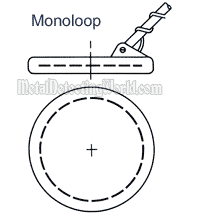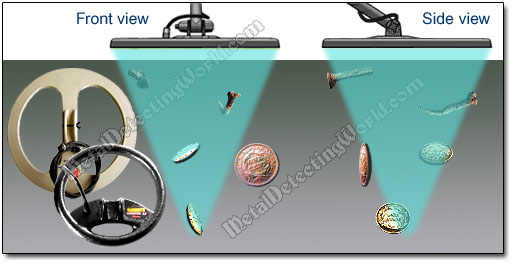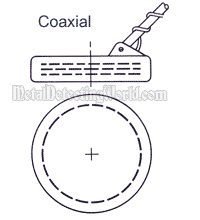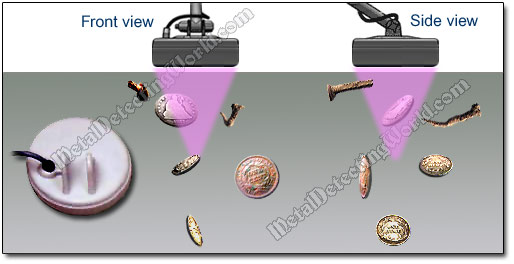Search Coils for Metal Detectors, page 4
Types of Search Coils: Monoloop and Coaxial Search Coils - Advantages and Disadvantages of Design
3) Monoloop

Monoloop is the type of search coils in which the multiple strands of wire are wound in a single loop around the circumference of the coil. The electromagnetic field detection pattern of a Monoloop coil is cone-shaped (extending above and below the coil windings), which requires overlapping of sweeps to ensure thorough ground coverage. Monoloop coils can be of either round or Semi-Elliptical designs.
Monoloop Coil Drawbacks:
• In highly mineralized soils, a Monoloop coil can be more difficult to Ground Balance and, therefore, possibly more noisy, and will be outperformed by the Double D coil.
• If overlapping of sweeps is not maintained, many targets will be missed due to the shape of the Monoloop coil's electromagnetic field detection pattern which is conical (same as the pattern of concentric coils).
Monoloop Coil Advantages:
• Monoloop coil provides greater depth and sensitivity compared to a Double D coil of equivalent size in low-medium mineralization.
Monoloop Search Coils and Their Electromagnetic Field Detection Pattern

4) Coaxial

This search coil design has identical diameter transmit and receive windings stacked and aligned on the same axis: the transmit winding is sandwiched by two receive windings in near perfect alignment on center. This creates an electromagnetic detection pattern of more uniform density and performance, and offers the best resistance to interference from high-voltage power lines. The electromagnetic field detection pattern of a Coaxial coil is also cone-shaped.
Because of its specific design, this type is seeing renewed usage only in smallest coils or "mini coils" of 4" in diameter. It would be impractical to use the coaxial coils of larger sizes due to unavoidable increase in coil's thickness and weight.
This type of search coil produces an opposite reaction topside compared to the bottom when sensing a target. If you have the habit of passing a handful of dirt over the top of search coil during recovery to verify whether the target is still in the hole or not (as described in "Plug-Splitting Technique" on "How To Metal Detect" page), you should not do so when using a coaxial search coil.
If a target is accepted on the underside, passing the same target topside will make no sound. The target hiding in the dirt in your hand will seem to "disappear", further confusing your recovery.
Coaxial Search Coil and Its Electromagnetic Field Detection Pattern

Coaxial Coil Drawbacks:
• Small detection depth - disadvantage of all "mini coils"
• By virtue of their smallest coverage area and conical electromagnetic field detection pattern, coaxial coils impose a very disciplined scan rate and overlap which, if not maintained, may result in missing many targets.
Coaxial Coil Advantages:
• Uniform electromagnetic field detection pattern
• Better separation of trash and desirable targets in close proximity
• Ability to detect closer to metal poles without detecting them compared to other designs
• Resistance to 60 Hz AC electrical interference